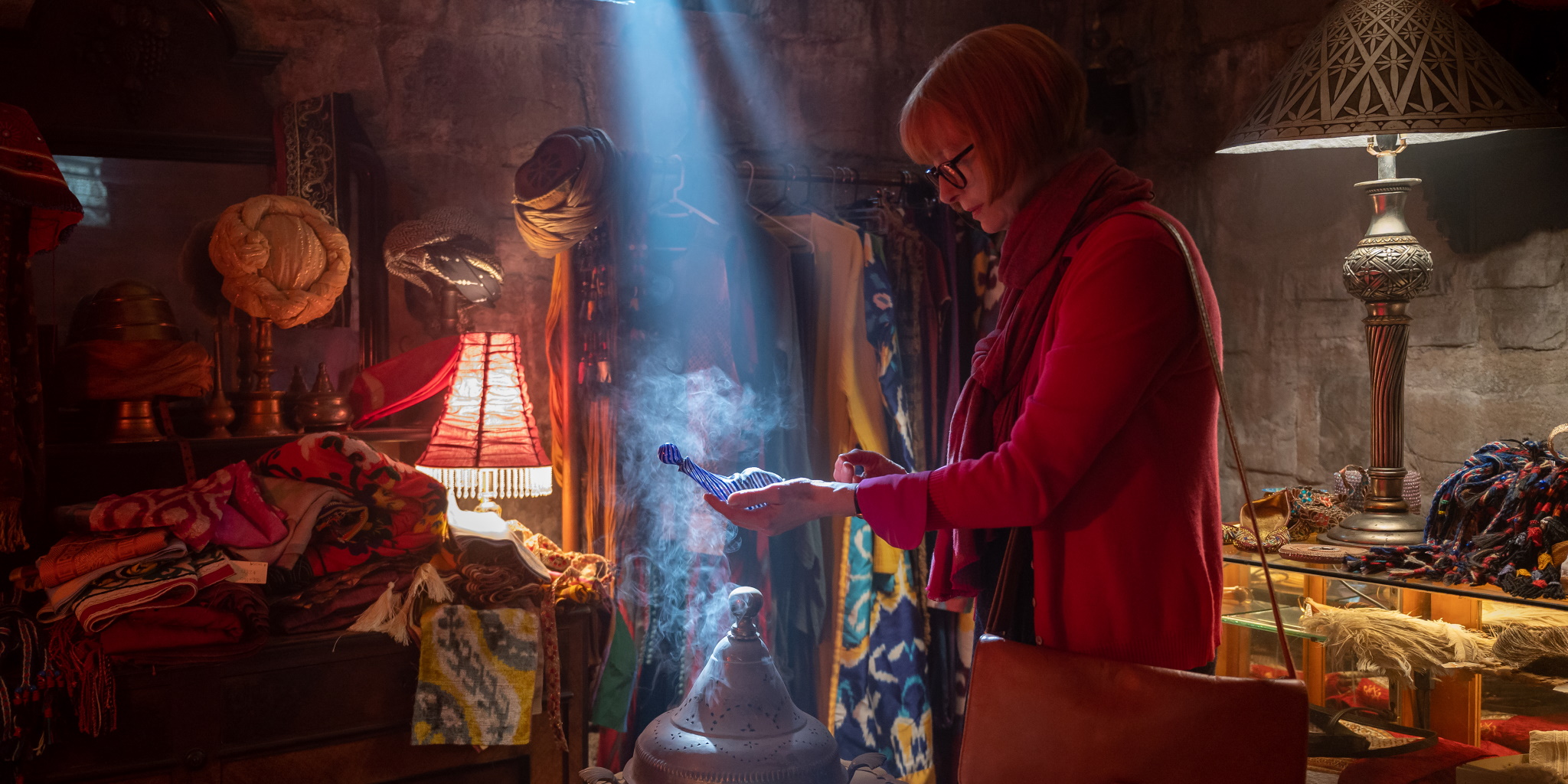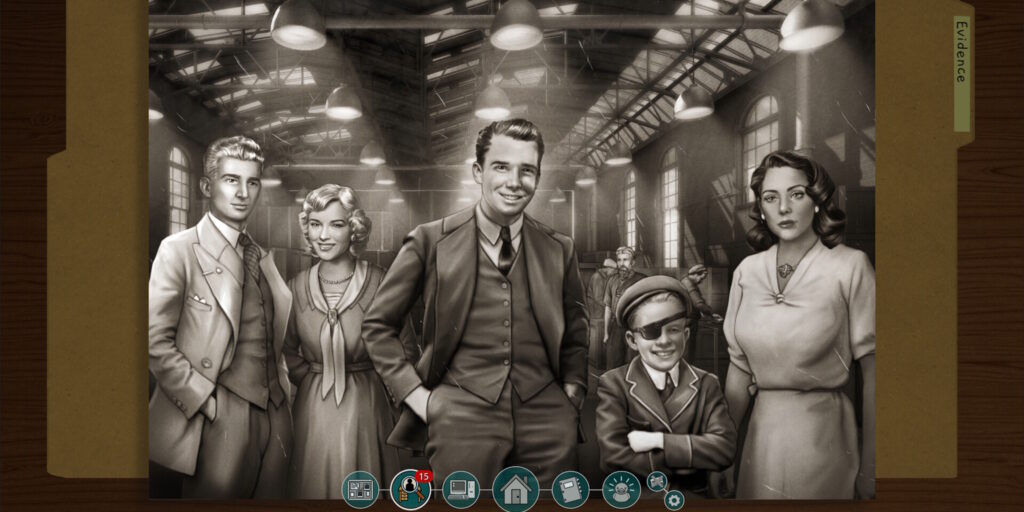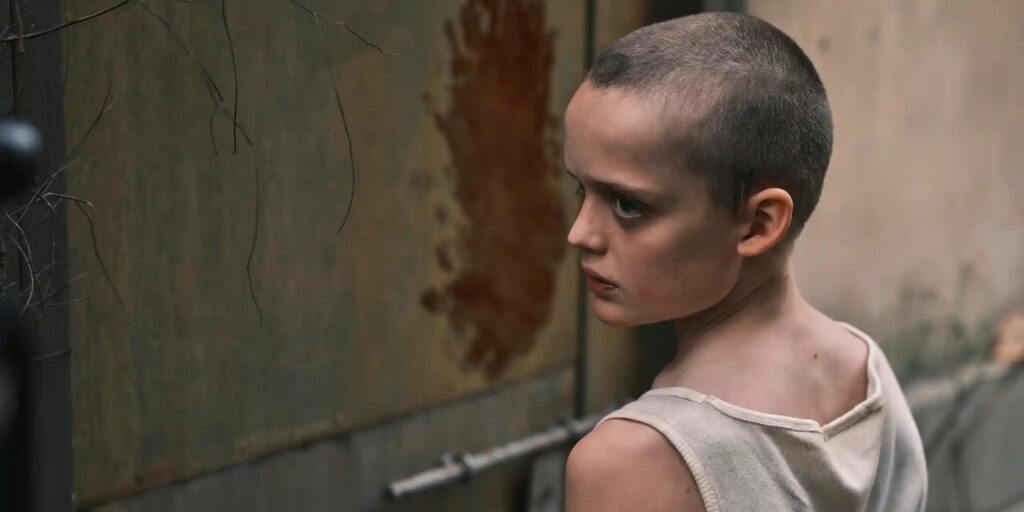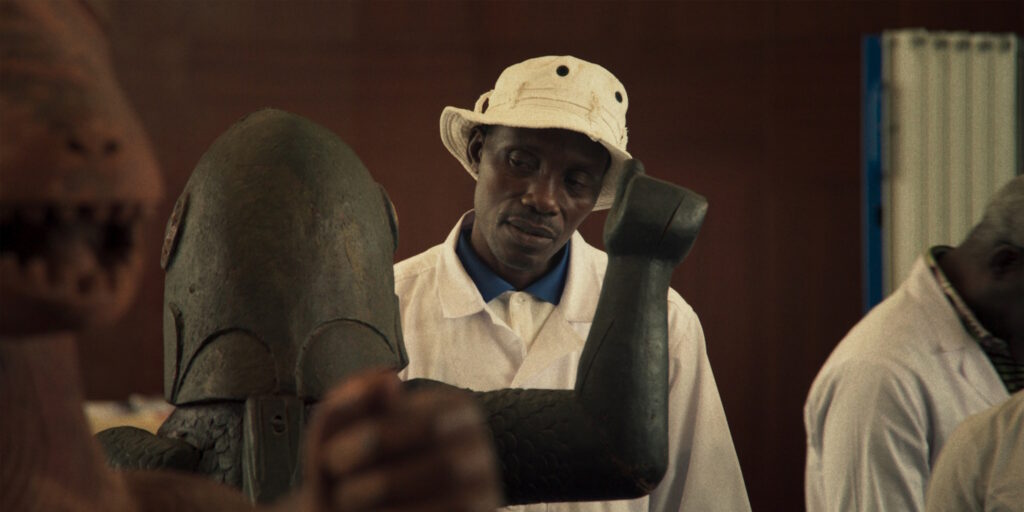[Originally published at Cinema St. Louis’ The Lens.]
Dr. Alithea Binnie (Tilda Swinton) knows a lot about myths, legends, and fairy tales. She is a “narratologist,” one of those faintly ludicrous academic disciplines that only seems to exist in movies. (See also: The Da Vinci Code’s “symbologist,” Robert Langdon.) Simply put, Alithea is an expert on stories: their structure, their evolution, and their role in humankind’s timeless struggle to make sense of its own existence. As a no-nonsense intellectual, her interest in the fantastical is that of a scholar rather than a true believer. When her childhood imaginary friend, Enzo, stopped appearing to her decades ago, she put away such flights of fancy – much as she summarily boxed up, labeled, and shelved her philandering ex-husband’s things.
However, lately Alithea has been seeing things, such as the peculiar, goblin-like fellow who bumps into her at the Istanbul airport, or the pale goliath whose glowering presence later causes her to faint during her keynote lecture at an academic conference. Alithea brushes off the incident, shamefacedly admitting to a colleague that her imagination sometimes gets the better of her. She finds diversion in the city’s bazaars, where she digs a tiny, misshapen glass bottle from a pile of unsorted curios – a perfect little memento of her trip. The next morning, while she is cleaning the dirt-encrusted vessel with her electric toothbrush, the stopper pops loose, unleashing a torrent of purple and vermilion smoke. To her astonishment, these fumes coalesce into a pointy-eared, sparkly-skinned man (Idris Elba) so colossal that his well-muscled bulk fills her entire hotel suite.
For about 10 seconds, Alithea entertains the possibility that she is hallucinating this otherworldly being, but soon her rational pragmatism takes over, compelling her to understand the parameters of the situation. After adjusting his stature to less intimidating proportions, the man confirms her new Arabian Nights reality: He is an immortal djinn, and he is bound to grant her three wishes for releasing him from his mystical prison. Fate has a perverse sense of humor, however, as Alithea might be the worst living candidate for such a magical boon. She claims that she is quite content with her life as-is, and try as she might, no unfulfilled desires or sky-high fantasies spring to mind. What’s more, she knows exactly how tales of magic lamps and monkey’s paws inevitably turn out. Stories about wishes are always stories about the dangers of wishing, and Alithea is not about to make the same blunders as the short-sighted heroes from her studies.
Out of genuine curiosity – and perhaps as a bit of a stalling tactic – she urges the djinn to explain the circumstances of his imprisonment. And so, wrapped in fuzzy hotel robes and snacking on conjured delicacies, the pair settle in for the djinn’s centuries-spanning tale, a tripartite saga of love, war, and magic. It ranges from the Kingdom of Sheba in 9th-century BCE East Africa to the Topkapi Palace of the 16th-century Ottoman Empire to distant points beyond. The djinn speaks ruefully of his own foolishness and of the fickle twists of fortune that bound him three times over the course of three millennia. As loath as he is to admit it, much of the blame for his present circumstances can be traced back to his heedless love for a mortal woman.
Adapted from a short story by acclaimed British author A.S. Byatt (Possession: A Romance), Three Thousand Years of Longing has been a long-gestating project for filmmaker George Miller, who penned the screenplay with his daughter Augusta Gore. Miller is best known for his genre-defining Mad Max saga, but the earnest and eccentric Three Thousand Years is closer in spirit to the director’s nominally family-friendly films, such as Babe: Pig in the City (1998) and Happy Feet (2006). Given its literary roots and insatiable horniness, however, its nearest relation in Miller’s filmography is probably 1987’s The Witches of Eastwick. Although the djinn never gives off a whiff of demonic menace – his mingled air of ageless world-weariness and self-loathing vulnerability is part of his charm – it’s impossible to make a shirtless Elba unsexy. Particularly when his enchanted flesh smokes and shimmers like a roiling cauldron, or when he purrs lines like, “You are dust, but I am made of subtle flame.”
The film plainly originates from a place of enthusiasm, offering Miller a chance to play in an opulent, unabashedly fantastical sandbox. It’s certainly easy to see why the director’s longtime collaborator, cinematographer John Seale, once again agreed to emerge from retirement, given the film’s lush realization of never-was locales in Ethiopia and Turkey. Production designer Roger Ford has fashioned fantasy worlds before in Peter Pan (2003) and a pair of Narnia films (2005, 2008), but here his work takes on an even more heightened flavor, giving a storybook sensibility even to scenes set in early-19th-century Istanbul. It’s the kind of film that will invite future scrutiny from art-direction geeks, who will be poring over freeze frames, marveling at all the weird creatures in the background of Queen Sheba’s throne room.
Three Thousand Years is a decidedly messy, idiosyncratic film, despite the structure provided by the framing narrative and the djinn’s three tales. These chapters are markedly different in terms of length – the first is the shortest, the second the longest – but this unevenness doesn’t emerge naturally from the djinn’s hotel-room storytelling, which renders it somewhat distracting. Most frustratingly, the screenplay noticeably runs out of steam in its final, extended stretch. The film dawdles over agreeably weird but fruitless asides and seems to pace in narrative circles as if waiting for the characters to catch up. While the script does feature some satisfying callbacks and dramatic payoffs, the whole thing just feels distinctly lumpy. It’s rambling and visibly uncertain of its course – if not its destination – lacking the crisp confidence of a well-told anecdote.
Then again, perhaps this is the point. Myths and folk tales are often meandering, digressive affairs, after all, unfolding according to the uncanny logic of a fireside magic-mushroom trip. Whatever its faults, Three Thousand Years is bursting with affection for legendary fiction in all its strange, extravagant glory. At bottom, it’s a sumptuously mounted but deceptively simple story about stories, in the vein of The Adventures of Baron Munchausen (1988), Big Fish (2003), and The Fall (2006). Yet the film’s tone is perhaps most reminiscent of Neil Gaiman’s acclaimed The Sandman comic (1989-96), with its dark fantasy, tragic twists, and generally elegiac mood. (The excellent standalone Sandman tale “Ramadan,” with fantastic, arabesque art by P. Craig Russell, seems a likely touchstone.) Both Byatt’s original story and Miller’s adaptation are comparable to Gaiman’s work, finding creative inspiration – and more than a little wistfulness – in their nesting of stories within stories.
Three Thousand Years of Longing opens in theaters everywhere on Friday, Aug. 26.




